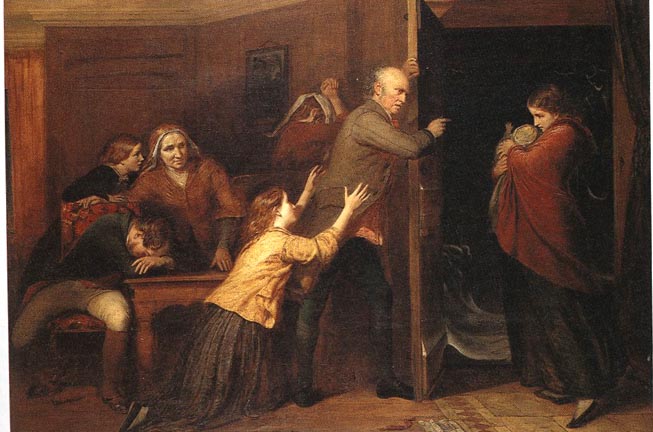TheGenealogist releases Norfolk Parish Records
Some of the records reveal the parents of illegitimate children
TheGenealogist has released over half a million new parish records for Norfolk into their Parish Records collection. In addition to containing the uniquely transcribed records of Baptism, Marriages and Burials with images for over 250 parishes, these records also include some fascinating Bastardy bonds, Examinations, Warrants and Orders. With this release family historians will be able to find the details of ancestors baptised, married and buried as well as those that had children born out of wedlock in this East Anglian county.

The Outcast. Richard Redgrave
The new data will allow the family history researcher to discover:
- Over half a million individuals in records
- Names of parents of illegitimate children
- Images also reveal the names of people standing guarantor for the father
- The baptism, marriages and burials of ancestors in Norfolk
These fully searchable records are transcribed from the original records and linked to the images from the Norfolk Record Office. This release covers the parishes of:
Acle, Alby, Antingham, Ashby with Oby, Ashby With Oby and Thurne, Ashill, Ashwellthorpe, Ashwicken, Aslacton, Babingley, Bacton, Banham, Barton Bendish All Saints & St Mary, Barton Bendish St Andrew, Bawsey, Beechamwell, Beighton, Billingford, Billingford with Thorpe Parva, Billockby, Bixley, Blickling, Booton, Boughton, Bracon Ash, Bradfield, Brancaster, Braydeston, Breccles, Bressingham, Brinton, Brundall, Buckenham, Bunwell, Burgh next Aylsham, Burgh St Peter, Burlingham St Edmund, Burnham Deepdale, Burnham Thorpe, Burnham Westgate, Caister St Edmunds & Trinity, Caistor St Edmunds, Calthorpe, Carleton Rode, Castle Rising, Caston, Catton, Chedgrave, Cawston, Chedgrave, Clippesby, Colney, Congham St Andrew, Corpusty, Croxton, Denton, Dersingham, Diss, Dunston, Earlham, East Bradenham, East Carleton, East Dereham, East Harling, East Lexham, East Tuddenham, East Walton, East Winch, Eccles, Edgefield, Edingthorpe, Elsing, Erpingham, Felthorpe, Fersfield, Flitcham, Flordon, Fordham, Forncett St Peter, Foulsham, Framingham Earl, Framingham Pigot, Fundenhall, Gayton, Gayton Thorpe, Gaywood, Gimingham With Trunch, Gissing, Glanford, Great Bircham with Bircham Newton and Bircham Tofts, Great Dunham, Great Fransham, Great Poringland, Great Snoring, Great Witchingham, Great Yarmouth, Great Yarmouth St Nicholas, Grimston, Griston, Guestwick, Haddiscoe, Hales, Hapton, Hardley, Hardwick, Hassingham, Heacham, Heckingham, Heigham, Hellington, Hethersett, Hilgay, Hingham, Hockering, Hoe, Holkham, Honingham, Horning, Horsford, Horsham St Faith, Howe with Little Poringland, Hunstanton, Ingoldisthorpe, Ingworth, Itteringham, Kempston, Kenninghall, Ketteringham, Kilverstone, Kirby Bedon, Knapton, Lammas with Little Hautbois, Langley, Limpenhoe, Lingwood, Little Barningham, Little Walsingham, Little Witchingham, Loddon, Ludham, Marham, Marlingford, Mattishall, Merton, Metton, Mintlyn, Morton on the Hill, Moulton, Moulton All Saints & St Michael, Moulton St Mary, Mulbarton, Mundesley, Narborough, Needham, New Buckenham, Newton Flotman, North Creake, North Elmham, North Lopham, North Pickenham, North Tuddenham, Northwold, Norton Subcourse, Norwich Lakenham, Norwich Pockthorpe St James, Norwich St John de Sepulchre, Norwich St Margaret and St Swithin, Norwich St Mary in the Marsh, Norwich St Peter Parmentergate, Old Buckenham, Oulton, Pakefield, Paston, Postwick, Pulham St Mary the Virgin, Quidenham, Redenhall with Harleston & Wortwell, Ringland, Ringstead St Andrew, Rockland St Mary with Hellington, Runcton Holme, Runton, Saham Toney, Salhouse, Sandringham, Saxthorpe, Sedgeford, Sharrington, Shelfanger, Shelton with Hardwick, Shingham, Shipdham, Sidestrand, Skeyton, Snetterton, Snettisham, Somerleyton (Suffolk), Southrepps, Southwood, Sparham, Sporle With Palgrave, Starston, Stiffkey, Stoke Holy Cross, Stow Bardolph, Stow Bedon, Stradsett, Stratton Strawless, Strumpshaw, Swaffham, Swannington, Swanton Abbot, Swanton Morley with Worthing, Swanton Novers, Swardeston, Tacolneston, Tasburgh, Tharston, Thetford St Cuthbert, Thetford St Mary, Thetford St Peter, Thompson, Thorpe By Haddiscoe, Thorpe Episcopi, Thorpe Market, Thurlton, Thwaite, Tibenham, Titchwell, Toft Monks, Toftrees, Tottenhill, Tottington, Trowse, Trunch, Tuttington, Upper Sheringham, Wacton, Warham, Watlington, Watton, Weeting St Mary With All Saints, Wereham, West Newton, Westacre, West Tofts, Wheatacre All Saints, Wickmere, Wighton, Winfarthing, Witton, Wolferton, Wolterton, Wood Norton, Wood Rising, Woodbastwick, Wormegay, Worstead, Worthing, Wreningham and Wretton.
Read TheGenealogist’s article: Tracing Illegitimate ancestors online
https://www.thegenealogist.co.uk/featuredarticles/2019/tracing-illegitimate-ancestors-online-1127/
About TheGenealogist
TheGenealogist is an award-winning online family history website, who put a wealth of information at the fingertips of family historians. Their approach is to bring hard to use physical records to life online with easy to use interfaces such as their Tithe and newly released Lloyd George Domesday collections.
TheGenealogist’s innovative SmartSearch technology links records together to help you find your ancestors more easily. TheGenealogist is one of the leading providers of online family history records. Along with the standard Birth, Marriage, Death and Census records, they also have significant collections of Parish and Nonconformist records, PCC Will Records, Irish Records, Military records, Occupations, Newspaper record collections amongst many others.
TheGenealogist uses the latest technology to help you bring your family history to life. Use TheGenealogist to find your ancestors today!
